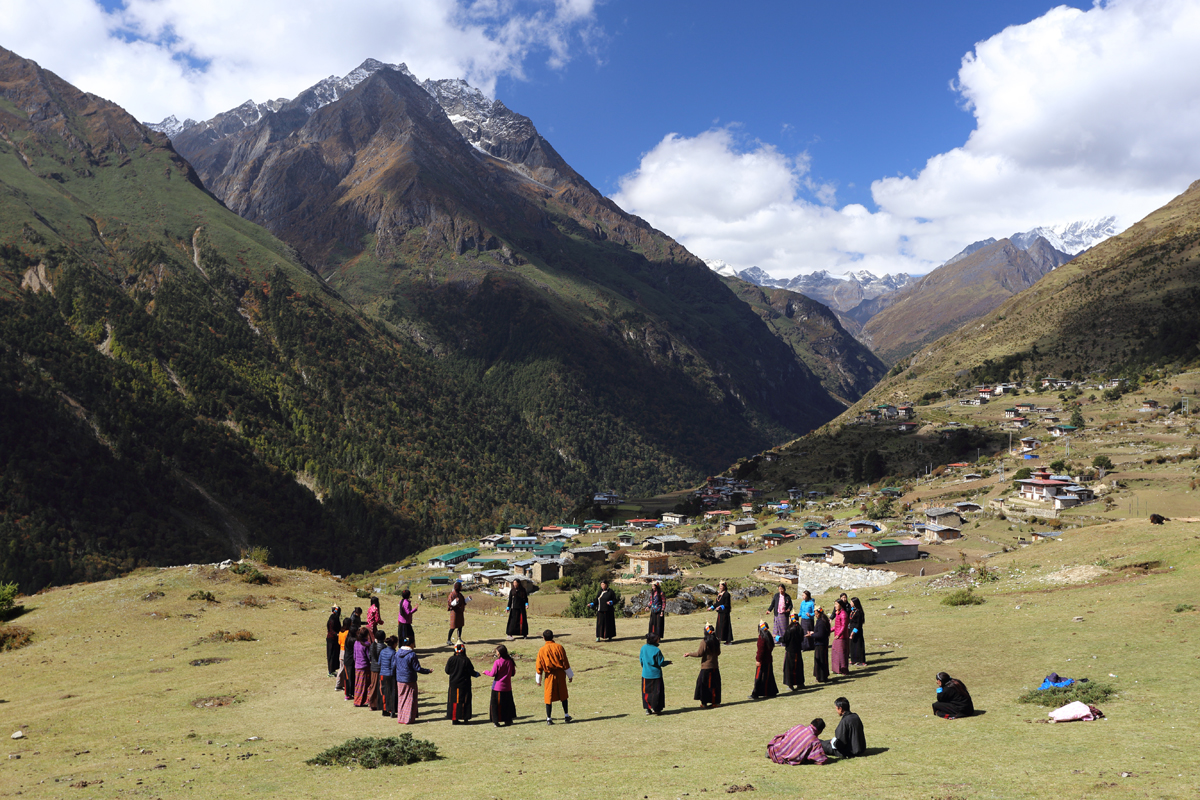Table of Contents
Toggle
Laya: Bhutan’s Hidden Highland Gem
Tucked away in the lap of the majestic Himalayas, perched at an altitude of 3,820 meters, lies Laya—a place where time seems to stand still, and the soul of Bhutan’s highland culture thrives. This remote village in the Gasa District is one of the highest settlements in Bhutan, home to the Layap people, whose unique traditions and way of life have remained largely untouched by the modern world. With its breathtaking landscapes, vibrant culture, and the celebrated Royal Highland Festival, Laya offers an experience unlike any other in the kingdom.
The Land of the Layap People
Laya is more than just a village; it’s a testament to the resilience and spirit of its people. The Layap, indigenous to this region, have carved out a life in one of the most rugged and isolated terrains of Bhutan. Their traditional homes—dome-shaped structures made of bamboo and stone—dot the undulating hills, blending seamlessly into the vast, pristine landscape. Clad in their distinctive black woolen attire and conical bamboo hats, the Layap people radiate warmth, hospitality, and a deep connection to their environment.
Living in harmony with nature, the Layaps depend on yak herding and the collection of medicinal plants for their livelihood. Yaks are integral to their existence, providing everything from milk and butter to clothing and transportation. The bond between the Layap and their yaks is celebrated every year at the Royal Highland Festival, an event that showcases the culture and traditions of Bhutan’s highland communities.
The Royal Highland Festival: A Cultural Extravaganza
Each year, on October 23rd and 24th, in the rolling hills of Laya, the Royal Highland Festival brings together the highland communities from across Bhutan for a grand celebration. The festival, initiated in 2016 by His Majesty the King of Bhutan, aims to promote and preserve the unique highland cultures, while also boosting sustainable tourism in the region.
Visitors to the festival are treated to a spectacular display of traditional songs, dances, and sports, including archery, horse riding, and yak racing. The festival also features exhibitions of highland crafts, local cuisine, and livestock competitions, where the finest yaks and horses are paraded in a show of strength and beauty. It’s a celebration of the deep-rooted connection between the people, their animals, and the land they call home.
The Royal Highland Festival is more than just an event; it’s an immersive experience that allows visitors to witness the way of life in one of the most remote parts of Bhutan. Set against the backdrop of the towering Himalayas, with the crisp mountain air and the distant hum of traditional Layap songs, it’s an experience that stays with you long after the festival ends.
A Journey Through Untamed Beauty
Getting to Laya is no small feat, but the journey is as rewarding as the destination. The village is accessible only by trekking through the wild, unspoiled landscapes of the Gasa District. The trek from Gasa Dzong to Laya is part of the famed Laya-Gasa Trek, one of Bhutan’s most scenic high-altitude treks. As you ascend through dense forests, cross crystal-clear rivers, and wind your way through alpine meadows, you’ll be greeted by panoramic views of snow-capped peaks and an ever-changing landscape that leaves you breathless.
And now, with the construction of a road inching closer to Laya, this hidden gem is slowly becoming more accessible to travelers seeking adventure and solitude. The road, which has been under construction since 2012, is expected to cut down travel time significantly, making it easier for visitors to explore this beautiful highland village.
A World Beyond Time
Laya is a place where modernity hasn’t yet pierced the cultural fabric. It’s a village where people live in sync with the rhythm of nature, where festivals celebrate the ancient ways of life, and where the air is filled with the mysticism of Bhutan’s spiritual heritage. The Gasa Hot Springs, not far from Laya, offer a retreat for travelers seeking relaxation, while the towering peaks of Mount Gangchhenta and Mount Tsenda Kang watch over the village like silent guardians.
Visiting Laya is more than just a trip; it’s a journey into Bhutan’s soul. Here, amidst the towering Himalayas and the tranquil valleys, you’ll find a land that’s as wild and beautiful as it is peaceful and serene. Laya stands as a testament to Bhutan’s enduring commitment to preserving its natural beauty and cultural heritage.
For those who seek an adventure off the beaten path, a visit to Laya is an experience that will leave you awestruck and inspired, as the mountains, the people, and the spirit of the place all come together in perfect harmony.
How to Reach Laya, Bhutan
Reaching the remote village of Laya requires a combination of road travel and trekking through Bhutan’s scenic and rugged landscapes. The village, located at an altitude of 3,820 meters, is nestled deep in the Gasa District and offers spectacular views of the surrounding Himalayan peaks. Here’s a guide to reaching Laya:
1. Travel to Bhutan
- By Air: The quickest way to enter Bhutan is by flying to Paro International Airport, the country’s only international airport. Flights to Paro are available from major cities like New Delhi, Kolkata, Kathmandu, and Bangkok via Bhutanese airlines such as Druk Air and Bhutan Airlines.
- By Road: If you’re already in India, you can enter Bhutan by road through the Phuentsholing border crossing, which is connected to cities like Siliguri and Kolkata. From Phuentsholing, you can continue your journey by road to Thimphu or Punakha.
2. Travel from Paro/Thimphu to Gasa
- From Paro to Thimphu: After arriving at Paro, you can take a 1.5-hour drive to Thimphu, Bhutan’s capital.
- Thimphu to Gasa: From Thimphu, travel by road to Gasa Dzong, the nearest accessible town to Laya. The drive from Thimphu to Gasa takes about 7-8 hours and covers approximately 170 km. The route passes through beautiful landscapes, including the famous Punakha Dzong and the Dochula Pass.
3. Road and Trek to Laya
The road to Laya is under construction and currently extends to Taktse Makha, shortening the trekking distance significantly. Here’s how the journey unfolds:
- Gasa to Taktse Makha: The new road is being extended by 6.1 km from Tongchudrak to Taktse Makha, and is expected to be completed by April 2025. Once finished, it will make the trek shorter.
- Trek from Taktse Makha to Laya: From Taktse Makha, you will need to trek about 10 km to reach Laya. The trek takes about 2 days in total from Gasa to Laya and involves high-altitude trails passing through pristine forests, meadows, and valleys. The scenery is stunning, with the trek offering views of the Gangchhenta and Tsenda Kang mountains.
- Day 1: Trek from Taktse Makha to Kohina (about 20 km, 6-7 hours).
- Day 2: Trek from Kohina to Laya (about 30 km, 8-9 hours).
4. Permits and Guides
- Permits: Bhutan requires tourists to obtain trekking permits, which can be arranged by your travel agency or guide. You’ll also need to arrange for a local licensed Bhutanese guide.
- Guides and Porters: Since Laya is located in a remote area, it is recommended to hire porters and guides familiar with the terrain. They will assist you with navigating the trek and carrying your supplies.
5. Altitude and Fitness
The trek to Laya is a high-altitude journey, so it’s important to acclimatize properly to avoid altitude sickness. Prior trekking experience is recommended, as the trek can be physically demanding. It is advisable to spend time in Gasa or Punakha before starting the trek to adjust to the altitude.
Alternative: Laya-Gasa Trek
For more adventurous travelers, Laya is part of the famous Laya-Gasa Trek, a longer, more challenging high-altitude trek that covers some of Bhutan’s most remote and beautiful landscapes.
Reaching Laya may be challenging, but the rewards are immense—spectacular views, rich culture, and an unforgettable experience in one of Bhutan’s most isolated villages.

